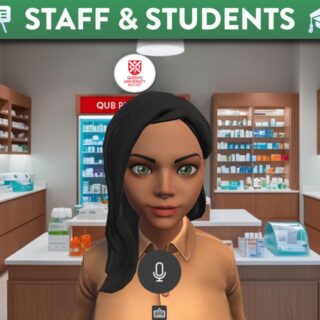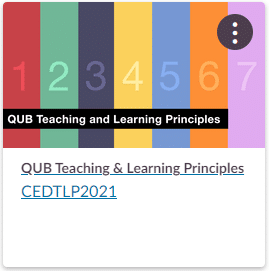
Connected Teaching and Learning Principles
The Centre for Educational Development (CED) have developed seven guiding principles to support the planning and delivery of teaching, learning and assessment at Queen’s. The seven principles are:
Blended by Design
Student Voice Student Choice
Communities
Relevant & Global Curriculum
Authentic Assessment
Feedback for Learner Progression
Digital Skills
The Purpose of the 7 Principles:
The principles aim to highlight key areas to support your planning and delivery of teaching, learning and assessment. They provide a variety of ideas to inform your practice and enhance the student experience.
Why might I consider these principles?
The experience of teaching through the pandemic brought about a period of rapid, enforced change to teaching practices on a global scale. The pivot online saw a shift to fully online, blended and hybrid approaches to delivery, both teaching staff and students were challenged to find ways to interact and develop a sense of community in a digital world and traditional assessment methods of in-person examinations moved online and prompted a rethink of our assessment and feedback practices.
It is important to take the time to reflect on these experiences, consider what worked well and importantly what didn’t. Self-reflection is about making informed and intentional decisions about changes in practice, based on evidence and by drawing from multiple perspectives and sources. The 7 principles highlight the key areas to support your planning and delivery of teaching, learning and assessment, prompt reflection and provide a variety of suggestions to inform your practice through the lens of inclusive and accessible practice.
We hope that by exploring the online course you will pause to reflect on each guiding principle and adapt your teaching, learning and assessment practices to enhance the overall student experience in your subject area. We hope the 7 principles and accompanying resources will act as a catalyst for rich discussions with your teaching or programme teams and more widely within your school or faculty to bring about incremental change and a more Connected Teaching and Learning experience at Queen’s.
Helpful Resources
The ‘Connected Teaching and Learning Principles’ are accompanied by a concise, self-paced Canvas course that you can review in your own time and is located on your Canvas Dashboard. There is also an infographic poster to compliment the principles and the course.
Where do I start?
Access the QUB Teaching & Learning Principles course on your Canvas dashboard. It is succinct with only 7 pages to review, one for each of the 7 guiding principles. While they are numbered, the sequence is not significant so you can move through the course in linear fashion or dip in and out as preferred.
On each principle page you will find:
- Overviews of each principle
- Reference to where it maps to the UK Professional Standards Framework (UKPSF) or Universal Design for Learning (UDL) principles
- Reflective prompts to help you take a moment of pause and reflect on the principle and your current practice
- Examples or suggestions of how the principle could be applied in your own context
- Top 3 UDL Tips on how to incorporate this principle
- Links to further information, resources and tools
- List of references used
📖 Read & Reflect: Read each page and use the reflective prompts to take time to reflect on your own teaching, learning and assessment practice, your current curriculum and course design and the overall learning experience for students taking your courses.
💡 Consider: Consider the list of examples or suggestions of how you could apply each principle into your practice to help enhance the student experience.
🔍 Review: Review the Top 3 UDL Tips for simple but effective ways to weave UDL principles into your teaching and learning.
🎓 Be Informed: For more information, check out some of the spotlighted resources or tools or view the reference list for the original sources of information.
🎯 Take Action: Finally, take action. An idea might be to have one key takeaway from each principle that you can immediately put into practice and take your first step on the journey to making small incremental changes to improve your overall teaching, learning and assessment practices.


